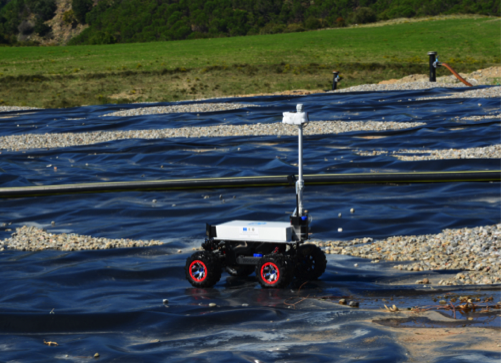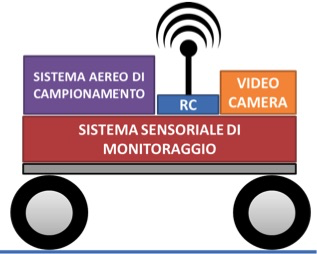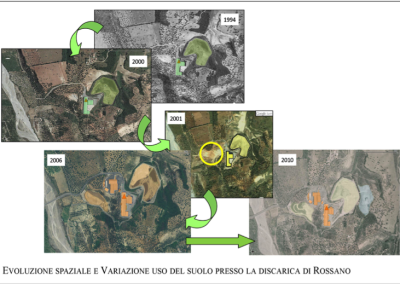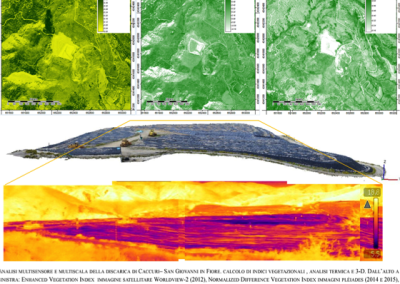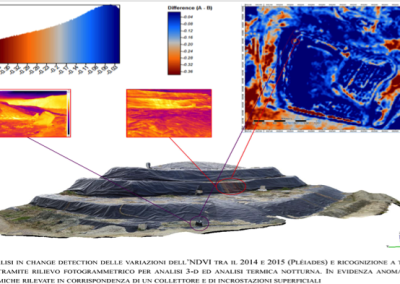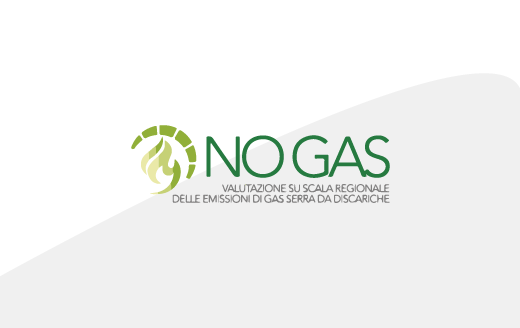
Abstract of the project
Climate problems have led in recent years to greater attention to the control of greenhouse gases in the atmosphere. It is known that the emissions are both punctual, ie coming from large combustion plants, and widespread. These emissions concern not only carbon dioxide (CO2), but also methane (CH4), which has a greenhouse effect 20 times higher than carbon dioxide, and other greenhouse gases. While the punctual emissions can be reduced by intervening on the production processes, the diffused ones are more difficult to control and reduce and it is therefore necessary to work for a more precise quantification, to understand their mechanisms and therefore, where possible, to reduce them.
These considerations are particularly relevant for CH4 produced by landfills. Landfills contribute about 20% to the global anthropogenic emission of CH4 and send into the atmosphere not only CO2 and CH4, but also numerous organic substances present in biogas with much higher greenhouse power.
the password for the video is: drone_terrestre
The methods used are based on internationally accredited evaluation procedures, in particular that of the accumulation chamber for the measurement of the flows diffused on MSW and similar plants. The flow data acquired are processed with methods coming from both mining statistics and geostatistics (eg conditioned simulations), in order to allow a quantification of biogas emissions from landfill and to associate an estimate of the error to this value. Once the areas characterized by a high diffuse flow have been identified, action is taken to reduce these emissions both on the improvement of the coverage system and on the collection system, defining a more effective intervention and management model. Diversified methods of air quality analysis and assessment are also applied, including remote sensing and multi-temporal analysis.
The assessment of the effects through the monitoring of air quality makes it possible to evaluate the effects due to the emissions of the monitored plants, to determine the impact of the activities connected with the disposal of waste on the air quality in the surrounding areas.
The production of an integrated analysis of geo-environmental variations through remote sensing techniques is aimed at a study of the survey sites through a multisensor and multiscale approach, defining spectral indices describing the geo-environmental conditions. The multitemporal database produced allows a characterization of any diffuse and / or punctual emission phenomena and their possible impact on the radiometric response of the neighboring areas. This analysis also allows for better planning of monitoring campaigns by improving the positioning of the monitoring network on the ground. The task of the CNR-IIA is to create an innovative mobile monitoring platform (on land and in the air) that allows real-time and multispatial monitoring of air quality and other environmental parameters (including morphological ones).
Finally, there is the definition of a technical support protocol for the optimization of containment systems for the mitigation of atmospheric emissions through the comparative analysis of the results obtained for evaluating the efficiency, integrated with experimental activities aimed at evaluating the best solution in technical / economic terms for the mitigation of emissions from landfill covers.
The dissemination of the results aims to disseminate the results of the project in the territory and in the scientific, institutional and industrial world. The CNR-IIA is responsible for WP2 relating to the assessment of fallout through air quality monitoring and remote sensing.
In detail, the remote sensing activities are aimed at a preliminary study, the production of a 3D reconstruction of the study area, the georeferencing of the available cartography and mosaic of the remote sensing images and the study of parameters of interest through classification techniques. A change detection analysis is also envisaged applied to multi-temporal images (satellite images from archives and / or aerial photos) for monitoring environmental variations both within and adjacent to landfill areas.
In order to produce a 3-dimensional reconstruction of some areas located inside the chosen landfill (San Giovanni in Fiore), a telescopic carbon fiber rod is used that reaches 9 meters in height with the possibility of carrying out intermediate steps and therefore to obtain different altimetric configurations. A Gimball is connected to its top which allows the camera to be stabilized while maintaining the orientation of the platform in the desired position.
As regards air quality monitoring, the methods adopted are the traditional ones (preliminary assessment with passive samplers, see figure relating to the monitoring grid) combined with the development of innovative monitoring systems.
In detail, the project allowed the design and construction of a prototype of a terrestrial mobile system capable of carrying out measurements on landfill sites.
The design was aimed at monitoring some pollutants present in industrial waste treatment plants. The mobile system designed falls into the class of "terrestrial rovers" used for some years for monitoring / manipulation functions in environments hostile to humans. The peculiarity of the designed “rover” is its low cost and the ability to monitor a wide range of environmental pollutants, both gaseous and solid. In particular, the rover we built (RIIA) will be able to monitor gases such as CO2, H2S, CO and solid pollutants such as PMx.
The monitoring system on board the RIIA is based on electrochemical sensors for CO2, CO, H2S and on an optical interferometric system coupled to an experimental gravimetric system for the measurement of particulates (PM1, PM2.5, PM10). Furthermore, RIIA will be equipped with an aerial module for active sampling capable of stationing at different altitudes (1m, 2m, 3m) as needed.
• Biochemistry control
• CNR-IIA - Partner in charge of WP2 (EVALUATION OF RELAPSE THROUGH AIR QUALITY MONITORING AND REMOTE SENSING)
Alessandro Mei
Cyrus Manzo
Emiliano Zampetti
Sergio Cinnirella
Alessia Allegrini
Christian Bassani
Catia Balducci
Paula Romagnoli
Angel Cecinato
Matthias Perilli
Francesca Vichi
Andrea Imperiali
Massimiliano Frattoni
Antonella Macagnano
Francesco Petracchini
Marco Secret

